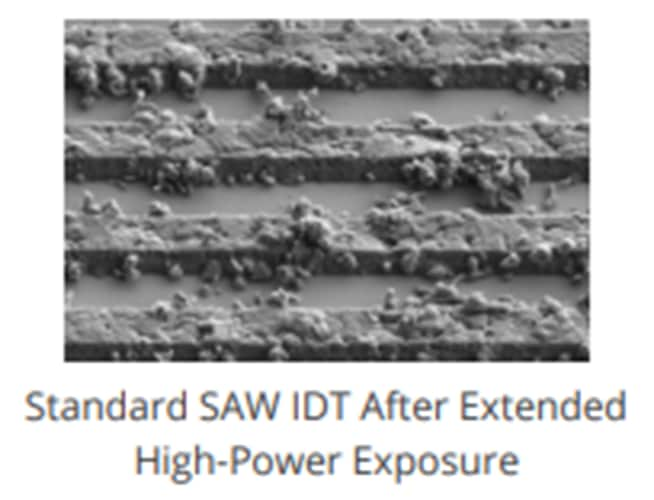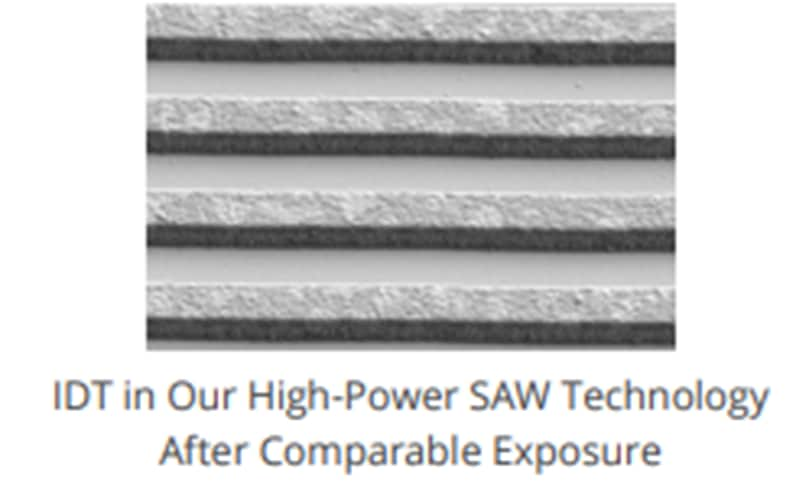Cutting-Edge SAW Oscillators: Harnessing Acoustic Waves for Robust Applications
Surface Acoustic Wave (SAW) oscillators are essential for high-frequency signal generation, leveraging piezoelectric materials to produce precise oscillations crucial for applications requiring accuracy and miniaturization. These devices utilize interdigitated transducers (IDTs) to generate and detect mechanical waves, making them an excellent choice for telecommunications, aerospace, defense and consumer electronics due to their exceptional stability and low phase noise. Advances in material science and fabrication techniques continue to enhance the performance and capabilities of SAW oscillators, ensuring their pivotal role in next-generation electronic systems like IoT and 5G networks.
Surface Acoustic Wave (SAW) oscillators are a sophisticated class of electronic components that have become indispensable in the realm of high-frequency signal generation. These devices leverage the unique properties of piezoelectric materials to produce precise oscillations, which are fundamental in a myriad of applications where accuracy and miniaturization are paramount.
Fundamentals of SAW Oscillators
The operation of SAW oscillators is rooted in the piezoelectric effect, where certain materials generate an electric charge in response to mechanical stress. Conversely, these materials can also deform when an electric field is applied, a phenomenon that SAW devices exploit to generate and detect mechanical waves.
(SAW devices utilize acoustic waves that travel along the surface of a material. An interdigitated transducer (IDT) is a key component in SAW devices, which are used in various applications such as filters, sensors and oscillators.
At the core of a SAW oscillator is the Inter-Digitated Transducer (IDT), a component consisting of finely patterned electrodes on a piezoelectric substrate. The IDT consists of two sets of metallic finger-like electrodes that are interdigitated, meaning they are interlocked like the fingers of two clasped hands, but not touching. These electrodes are deposited on a piezoelectric substrate—a material that generates an electric charge when mechanically stressed.
 |
Here's how an IDT works in a SAW device:
- Input Signal: When an alternating current (AC) electrical signal is applied to one set of electrodes in the IDT, the piezoelectric effect causes the substrate to deform slightly at the frequency of the signal. These surface acoustic waves have much shorter wavelengths compared to electromagnetic waves at equivalent frequencies, which is a key factor in the miniaturization of high-frequency components.
- Generation of SAW: This deformation generates a surface acoustic wave that propagates away from the IDT across the surface of the substrate.
- Propagation: The wave travels across the substrate surface, carrying with it the frequency and phase information of the original electrical signal.
- Interception by Output IDT: If the SAW device is designed as a filter or resonator, there will typically be a second IDT located some distance away from the first. The acoustic wave induces a stress in the piezoelectric material as it reaches this second IDT, which in turn generates an electrical signal due to the piezoelectric effect.
- Output Signal: This electrical signal is then output from the device, having been modified by the characteristics of the SAW (such as its velocity, which is affected by the properties of the substrate and the wave's interaction with any structures on the substrate).
The design of the IDT, including the number of finger pairs, their width, spacing and the material of the substrate, determines the frequency characteristics of the SAW device. By adjusting these parameters, engineers can tailor the device to specific applications, such as selecting a particular frequency band in a SAW filter or achieving a desired sensitivity in a SAW sensor.
Design and Miniaturization
The design of SAW oscillators is a delicate balance between physical dimensions and performance. Engineers must carefully consider the spacing and pattern of the IDT electrodes, as these parameters directly affect the frequency and efficiency of the acoustic waves. The ability to produce components with such small wavelengths allows for the creation of highly compact devices that can fit into tight spaces without sacrificing performance.
Performance and Stability
SAW oscillators are renowned for their exceptional stability and low phase noise, making them ideal for applications where consistent and reliable signal generation is critical. They exhibit remarkable resilience to environmental perturbations such as temperature changes, mechanical shocks and vibrations. This robustness is particularly valued in high-stakes industries like telecommunications, where signal integrity can be the difference between a clear communication line and a dropped call.
 |
Applications of SAW Oscillators
The applications of SAW oscillators are diverse and span across various sectors. In telecommunications, they are used in mobile phones, base stations and satellite communications for frequency selection and signal processing. The aerospace and defense industries rely on SAW oscillators for navigation systems, radar and secure communications. In consumer electronics, these components are found in televisions, radios and wireless devices, providing the necessary frequencies for operation.
 |
Engineering Challenges and Material Science
The engineering of SAW oscillators is a complex task that requires a deep understanding of material properties and wave dynamics. Developments in material science have significantly impacted the performance and capabilities of SAW oscillators.
Key advancements in SAW Oscillator Technology:
- Piezoelectric Materials: The core of SAW device technology is the use of piezoelectric materials, which convert electrical signals into mechanical vibrations and vice versa. Advances in the development of new piezoelectric materials, such as lithium niobate (LiNbO3), lithium tantalate (LiTaO3) and langasite (La3Ga5SiO14), have led to improvements in the performance of SAW oscillators.
- Temperature Compensated SAW (TC-SAW): Temperature fluctuations can affect the frequency stability of SAW oscillators. The development of temperature-compensated designs using materials with different temperature coefficients has helped in creating SAW oscillators that maintain a stable frequency over a range of temperatures.
- Low-Loss Materials: The reduction of propagation losses in SAW devices is crucial for high-performance applications. Research into new substrates and fabrication techniques has led to the development of low-loss materials, which improve the quality factor (Q-factor) of the SAW resonators and, consequently, the phase noise performance of the oscillators.
- High-Electromechanical Coupling Coefficient Materials: Materials with a high electromechanical coupling coefficient can convert energy between electrical and acoustic forms more efficiently, leading to better performance of SAW devices. This is particularly important for low-power applications.
- Advanced Fabrication Techniques: The precision of the SAW device's features directly affects its performance. Advances in lithography, etching and deposition techniques have allowed for the creation of finer features on the substrate, leading to higher frequency and lower phase noise SAW oscillators.
- Composite Substrates: The development of composite substrates, which combine different materials to exploit their respective advantages, has been a significant step forward. These can offer improved temperature stability, lower loss and better electromechanical coupling.
- Metamaterials: Research into artificial structures known as metamaterials has the potential to create substrates with custom-designed properties that could further enhance the performance of SAW devices.
- 3D Printing and Additive Manufacturing: These technologies are being explored for creating SAW devices with complex geometries and potentially for rapid prototyping or custom SAW oscillator designs.
- Nano Structuring: At the nanoscale, material properties can differ significantly from their bulk counterparts. Nano structuring of SAW device surfaces or the use of nanomaterials can lead to new ways of manipulating acoustic waves, potentially opening up new applications and performance enhancements.
- Diamond and Gallium Nitride (GaN): These materials have been explored for SAW devices due to their high thermal conductivity and potential for high-frequency operation. Diamond, in particular, offers excellent thermal properties, while GaN is known for its high-power handling capabilities.
These material science developments continue to push the boundaries of what is possible with SAW oscillators, leading to devices that are more stable, more precise and suitable for a wider range of applications.
Quality Factor and Frequency Stability
The quality factor, or Q factor, is a dimensionless parameter that describes how underdamped an oscillator or resonator is and characterizes a resonator's bandwidth relative to its center frequency. Higher Q factors indicate a lower rate of energy loss relative to the stored energy of the resonator; in other words, the oscillations die out more slowly.
For SAW oscillators, the Q factor is an important consideration because it affects the stability and phase noise of the oscillator.
Here are some considerations regarding the Q factor in SAW oscillators:
- Material Selection: The substrate material on which the SAW device is fabricated can significantly affect the Q factor. Materials with low acoustic loss, such as quartz or lithium niobate, are commonly used to achieve high Q factors.
- Device Design: The design of the interdigital transducers (IDTs) and the reflectors in a SAW device can influence the Q factor. Optimizing the spacing, width and number of finger pairs in the IDTs can help to maximize the Q factor.
- Operating Frequency: The Q factor of a SAW device typically increases with the operating frequency. Therefore, higher frequency SAW oscillators tend to have higher Q factors.
- Temperature Stability: The Q factor can vary with temperature. Some materials, like temperature-compensated cut quartz, are used to fabricate SAW devices that maintain a stable Q factor over a range of temperatures.
- Fabrication Techniques: The precision of the fabrication process can affect the Q factor. Imperfections in the IDTs or surface of the substrate can lead to energy loss and a lower Q factor. Advanced lithography and etching techniques can help to minimize these imperfections.
- Environmental Factors: The operating environment can also impact the Q factor. For instance, exposure to humidity, dust or other contaminants can degrade the performance of a SAW oscillator.
- Load Impedance: The impedance of the load connected to the SAW oscillator can affect its Q factor. An impedance mismatch can result in reduced energy transfer and a lower effective Q factor.
 |
 |
In applications where phase noise and frequency stability are critical, such as in telecommunications and precision timing devices, a high Q factor is essential. SAW oscillators with high Q factors are preferred in these cases because they offer better performance in terms of signal purity and stability.
The Future of SAW Oscillators
As technology continues to advance, the demand for smaller, more efficient and more reliable electronic components is ever-increasing. SAW oscillators are expected to play a pivotal role in the development of next-generation electronic systems, including the Internet of Things (IoT), 5G networks and beyond. Their ability to provide precise frequencies in a compact form factor makes them integral to the miniaturization trend in electronics.
 |
Conclusion
The convergence of miniaturization and performance in SAW oscillators is a testament to the progress of modern engineering. These components embody the intricate interplay between physics, material science and electrical engineering, culminating in devices that are both diminutive and powerful. As the electronic landscape evolves, SAW technology will continue to evolve and remain at the forefront, driving innovation and enabling new possibilities in robust applications.
For more information, check out our SAW oscillators web page.
